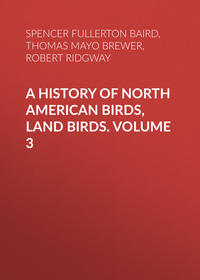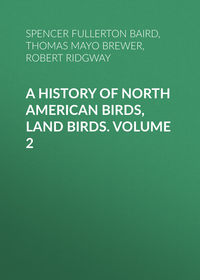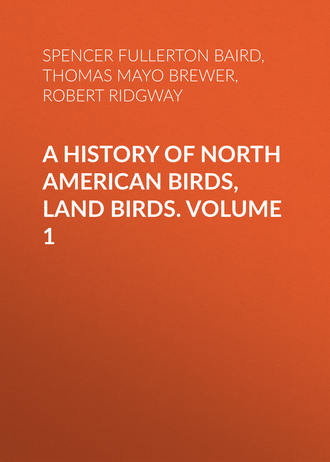 полная версия
полная версияA History of North American Birds, Land Birds. Volume 1
Hab. Eastern Province of United States; Eastern Mexico, and south to Bogota and Ecuador; Bahamas alone of West Indies with certainty.
Autumnal males resemble the females. They have two white bands instead of one; the black stripes on the sides are larger; under parts yellowish; the throat yellowish, passing into purer yellow behind.
Autumnal young birds have the same pattern of coloration, but the dark portions are dull grayish-umber, with the streaks very obsolete, and the light parts dull buffy-white, tinged with yellow on the jugulum; there is neither clear black, bright yellow, nor pure white on the plumage, except the latter on the wing-bands and tail-patches.
Habits. This somewhat rare and very beautiful Warbler requires additional investigation into its habits before its history can be regarded as satisfactorily known. Save in reference to its wider distribution during its southern migrations, little more is known as to its habits than where Audubon left its history nearly thirty years since. The Smithsonian collection has specimens from Pennsylvania, Ohio, Wisconsin, Missouri, Illinois, and from Central America. Mr. Sclater has received specimens from Mexico, and from Ecuador in South America. Other writers mention having specimens from Guiana, Martinique, and Panama, and Dr. Bryant found it in the Bahamas. It is thus known to have a wide distribution from the Atlantic to the Mississippi River, as far to the north probably as Labrador. Its area of reproduction is not known with exactness, but the southern limit is supposed to be the high wooded districts of Pennsylvania, New York, and New England. A young bird was taken by Holböll, October 16, 1845, at Frederikshaab, Greenland. In 1837 an egg was sent me from Coventry, Vt., which purported to belong to this bird; and in the following summer its nest and eggs were procured in a wild, secluded part of Roxbury, Mass. In neither case was the identification entirely free from doubt.
Dr. Bachman states that when a resident of Lansingburg, N. Y., in 1833, he saw a pair of these birds in the act of constructing their nest. Mr. Allen has no doubt that a few breed in the vicinity of Springfield, Mass., as he has obtained them as late as June 24. He found it most common in mixed or hard-wood forests. It arrives about the middle of May. Professor Verrill gives it as a summer resident of Western Maine, though rarely seen on account of its habit of keeping concealed among the dense foliage. Mr. Boardman gives the same account of its residence in summer in the neighborhood of Calais.
Mr. Audubon did not regard this bird and his “Hemlock Warbler” as the same species, but gave distinct and different accounts of their habits. We have therefore to receive with caution these records of peculiarities. He found the Blackburnian Warbler breeding in Northeastern Maine, in New Brunswick, in the Magdaleine Islands, and in Labrador and Newfoundland. He states, correctly, that it has a very sweet song of five or six notes, much louder than seemed possible from the size of the bird. It pursues its insect prey among the branches of the fir-trees, moving along after the manner of the common Redstart.
Mr. McCulloch, of Halifax, gave Mr. Audubon a nest of this bird with three eggs. The nest was formed externally of different textures, lined with fine delicate strips of bark and a thick bed of feathers and horse-hair. The eggs were small, conical, with a white ground spotted with light red at the larger end. The nest was in the small fork of a tree five feet from the ground, and near a brook.
The nest obtained in Roxbury was in a bush, a few feet from the ground, in a very wild region of forest and rocks. Externally, except in its length, which was less, it resembled a nest of the G. trichas, being made of coarse, dry grasses. Internally it was much more warmly lined with feathers and soft fur than is the case in nests of the Yellow-Throat. The eggs were of a crystal whiteness, marked at their larger end with dark purple, and but for their smaller size might have been mistaken for those of G. trichas. The position of the nest, however, was conclusive in regard to this point. The egg from Coventry was substantially similar, except that reddish-brown dots were mingled with the purple markings, in the form of a wreath around the larger end.
Wilson describes this Warbler as songless, but attributes to its counterpart, the Hemlock Warbler, a very sweet song of a few low notes,—a very different account from that given by Audubon of the song of the Blackburnian.
Mr. Paine states that this species is resident during the summer months in Randolph, Vt. It is, he says, a very close companion of the D. virens, arriving at the same time with it even to a day, or about the 10th of May. Its dry chirping song may then be heard in striking contrast with the sweet notes of the virens. He was not able to find its nest.
Mr. C. W. Wyatt met with this species as a winter resident at Alto, in Colombia, South America. Its upward range seemed to be terminated only by the paramos. Among the oaks on the Pamplona road he found it very common just under the paramo, the bright orange throat of the male making it a very conspicuous bird. He was led to believe that they were not found there at a lower elevation than five thousand feet.
Dendroica dominica, BairdYELLOW-THROATED GRAY WARBLERMotacilla dominica, L. Syst. Nat. 12th ed. 1766, 334 (Ficedula dominica cinerea, Briss. III, 520, pl. xxvii, fig. 3). Dendroica dominica, Baird, Rev. Am. Birds, 209. Motacilla superciliosa, Boddært, Tableau Pl. enl. 686, fig. 1, 1783. Dendroica superciliosa, Baird, Birds N. Am. 1858, 289.—Sclater (Xalapa, Oaxaca, Jamaica, Mexico).—Sclater & Salvin, Ibis, 1860, 274 (Duenas, Guat.; Sept.).—March, Pr. A. N. Sc. 1863, 293 (Jamaica).—Gundlach, Cab. Jour. 1861, 326 (Cuba; very common). Motacilla flavicollis, Gmelin, Syst. Nat. I, 1788, 959. Sylvia fl. Lath.; Wils. II, pl. xii, fig. 6. Motacilla pensilis, Gmelin, Syst. Nat. I, 1788, 960. Sylvia p. Lath.; Vieill. (St. Domingo).—Bon.; Aud. Orn. Biog. I, pl. lxxxv; Nutt. Sylvicola pens. Rich. Bon.; Aud. Birds Am. II, pl. lxxix.—Gosse, Birds Jam. 1847, 156 (Jamaica). Rhimanphus pens. Cab. Jour. III, 474 (Cuba).
Other localities: Cordova, Sclater, P. Z. S. 1856, 291. St. Domingo, Sallé, P. Z. S. 1857, 231. Jamaica, Gosse, Birds Jam. 156.
Sp. Char. Upper parts uniform grayish-blue. Chin and throat bright yellow; under parts white. Forehead, and sometimes most of crown, lores and cheeks, sides of throat, and numerous streaks on the sides of the breast, black. A stripe from the nostrils over and behind the eye, a crescent on the lower eyelid, the sides of the neck behind the black cheekpatch, and two conspicuous bands on the wings, white. Terminal half of the outer webs of the outer two, and terminal third of the third tail-feathers, white. Female almost precisely similar. Length, 5.10; wing, 2.60; tail, 2.30. (3,322.)
Hab. Eastern Province of United States, north to Washington and Cleveland; in winter abundant in Cuba; St. Domingo and Jamaica; Mexico (Colima on west coast), and Guatemala. Resident in Jamaica?
An autumnal male (No. 1,098, Washington, D. C.) has the bluish-ash above obscured by a wash of brown; the black “mask” less sharply defined, the streaks on forehead wanting; the yellow paler and duller, and the white beneath soiled with brownish.
In general pattern of coloration this species resembles two others; one from Arizona, the other from Porto Rico. The diagnoses are as follows:—
Common Characters. Upper parts ash-gray, the forehead and sides of vertex black. A line from nostril to above eye (passing into white behind), chin, and throat, yellow, margined laterally with blackish; crissum, inside of wings, axillars; and two bands on wings, white.
Superciliary line extending to the nape, and white, excepting sometimes anterior to the eye. Cheeks black, separated from the ash of the neck by a white patch. Eyelids and infra-ocular crescent white. Back not streaked. Bill lengthened, gonys almost concave.
Yellow confined to jugulum; rest of under parts white; the sides streaked with black … dominica.
Superciliary line scarcely extending beyond the eye, and yellow, excepting at extreme end. Cheeks ashy, like sides of neck; dusky only near the eye, and not bordered on side of neck behind by white. Eyelids and infra-ocular crescent yellow. Back streaked. Bill short, gonys slightly convex.
Yellow of under parts confined to jugulum; rest of under parts white; the sides streaked with black … graciæ.
Yellow of under parts extending to crissum. Sides scarcely streaked. … adelaidæ.51
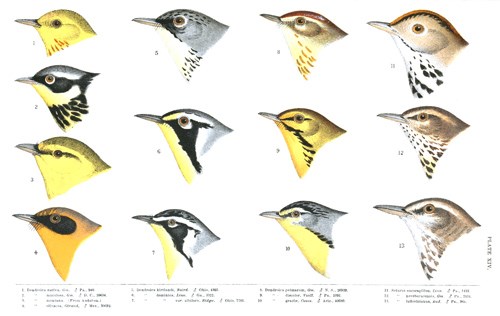
PLATE XIV.
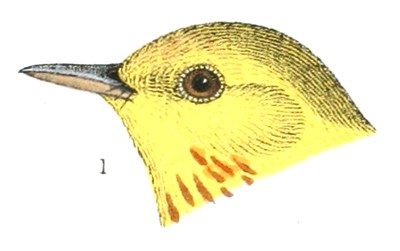
1. Dendroica æstiva, Gm. ♂ Pa., 940.

2. Dendroica maculosa, Gm. ♂ D. C., 20634.

3. Dendroica montana. (From Audubon.)

4. Dendroica olivacea, Giraud. ♂ Mex., 30692.
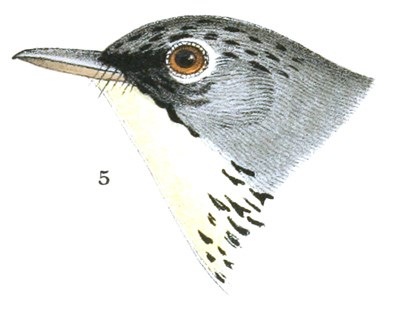
5. Dendroica kirtlandi, Baird. ♂ Ohio, 4363.
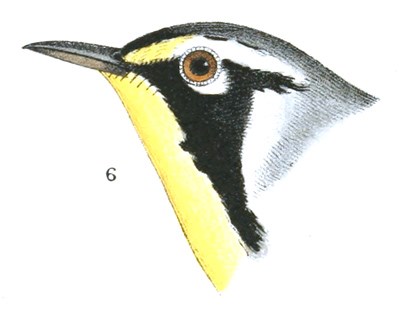
6. Dendroica dominica, Linn. ♂ Ga., 3322.
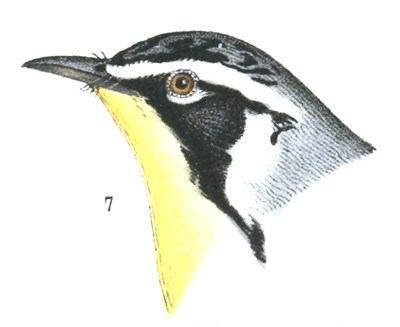
7. Dendroica dominica var. albilora, Ridgw. ♂ Ohio, 7701.
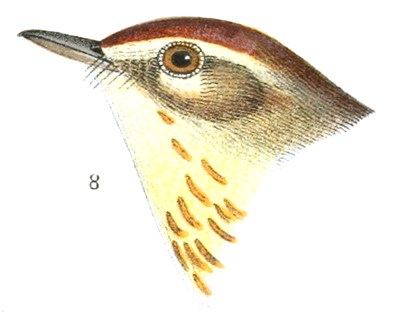
8. Dendroica palmarum, Gm. ♂ N. S., 26929.

9. Dendroica discolor, Vieill.♂ Pa., 1091.
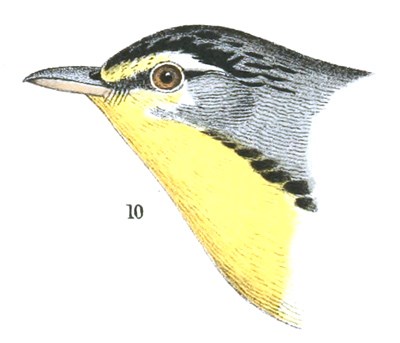
10. Dendroica graciæ, Coues. ♂ Ariz., 40680.

11. Seiurus aurocapillus, Linn. ♂ Pa., 1433.

12. Seiurus noveboracensis, Gm. ♂ Pa., 2434.

13. Seiurus ludovicianus, Aud. ♂ Pa., 964.
In the Review (p. 209) several variations in this species are noted; but at that time there was not a sufficient number of specimens to warrant our coming to a conclusion as to their value. Now, however, we have better material before us, and upon the examination of about thirty specimens, including two series of nearly equal numbers,—one from the Atlantic States and the West Indies, the other from the Mississippi region and Middle America,—find that there are two appreciably different races, to be distinguished from each other by points of constant difference. All birds of the first series have the bill longer than any of the latter, the difference in a majority of the specimens being very considerable; they also have the superciliary stripe bright yellow anteriorly, while among the latter there is never more than a trace of yellow over the lores, and even this minimum amount is discernible only in one or two individuals. The West Indian form is, of course, the true dominica, and to be distinguished as var. dominica; as none of the synonymes of this species were founded upon the Mexican one, however, it will be necessary to propose a new name; accordingly, the term var. albilora is selected as being most descriptive of its peculiar features.
The following synopsis, taken from typical specimens, shows the differences between these two races:—
(No. 3,322, ♂, Liberty County, Georgia.) Bill (from nostril), .45; tarsus, .60; wing, 2.60; tail, 2.00. Superciliary stripe, anterior to eye, wholly bright yellow; yellow of chin and maxillæ extending to the bill. Hab. In summer, Atlantic States of United States, north to Washington. In winter, and possibly all the year, in Cuba, Santo Domingo, and Jamaica … var. dominica.
(No. 61,136, ♂, Belize, Honduras.) Bill (from nostril), .35; tarsus, .60; wing, 2.70; tail, 2.20. Superciliary stripe wholly white; yellow of chin and maxillæ bordered narrowly next the bill with white. Hab. In summer, the Mississippi region of United States, north to Lake Erie; common in South Illinois. In winter, and possibly all the year, in Mexico, south to Guatemala, Yucatan on the Atlantic, and Colima on the Pacific side … var. albilora.
Habits. The history of the Yellow-throated Warbler is very imperfectly known. Its geographical distribution is irregular and apparently eccentric. Found occasionally, rather than frequently, in the Southern Atlantic and Gulf States, it occurs irregularly as far north as Washington, New York City, Cleveland, O., Union County, Ill., and Kansas. In the last place it is supposed also occasionally to breed. West of this it has not been traced in any portion of the United States. It was obtained in Tamaulipas, Mexico, by Lieutenant Couch, and on the western coast Mr. Xantus found it at Colima. Mr. Sclater has also procured it from other portions of Mexico, and M. Boucard took it at Oaxaca. It has been obtained in Guatemala and Jamaica. In the latter place it is found the entire season. In Cuba, in the winter, it is quite common. It has also been found in St. Domingo, and probably in the other West India Islands. Mr. Gosse states that these birds do not appear in Jamaica before the 16th of August, and that they leave by the first of April. On the other hand, Mr. March, in his notes on the birds of that island, states that on the 8th of August he obtained an old bird and two young, the latter of which he was confident had been hatched on the island, and his son had met with the birds all through the summer, and had procured a specimen on the 4th of June.
Wilson states that the habits of this species partake more of those of the Creeper than of the true Warbler. He met with it in Georgia in the month of February. He speaks of its notes as loud, and as resembling those of the Indigo-Bird. It remained some time creeping around the branches of the same pine, in the manner of a Parus, uttering its song every few minutes. When it flew to another tree, it would alight on the trunk and run nimbly up and down in search of insects. They are said to arrive in Georgia in February, after an absence of only three months. Wilson states that they occur as far north as Pennsylvania, but does not give his authority. The food of this species appears to be larvæ and pupæ, rather than winged insects. Those dissected by Mr. Gosse in Jamaica were found to have quite large stomachs, containing caterpillars of various kinds.
Nuttall and Audubon are very contradictory in their statements touching its nesting, and it is not probable that the accounts given by either are founded upon any reliable authorities. The former describes a nest remarkable both for structure and situation, said to have been found in West Florida, suspended by a kind of rope from the end of branches over a stream or a ravine. This nest, entirely pensile, is impervious to rain, and with an entrance at the bottom. He gives a very full and minute description of this nest, but gives no authority and no data to establish its authenticity. We can therefore only dismiss it as probably erroneous.
On the other hand, Mr. Audubon claims to have seen its nest, of which he gives a very different account. He describes it as very prettily constructed, like the nests of any other of this genus, its outer parts made of dry lichens and soft mosses, the inner of silky substances and fibres of the Spanish moss. The eggs are said to be four in number, with a white ground-color and a few purple dots near the larger end. He thinks they raise two broods in a season in Louisiana. These nests are not pensile, but are placed on the horizontal branch of the cypress, from twenty to fifty feet above the ground. It closely resembles a knot or a tuft of moss, and therefore is not easily discovered from below.
A nest containing a single egg, found by Mr. Gosse near Neosho Falls, and supposed to belong to this species, but not fully identified, was built in a low sapling a few feet from the ground, and is a very neat structure, such as is described by Audubon. The egg is pure crystal-white, oblong and pointed, and marked with purple and brown.
Mr. Ridgway informs me that in Southern Illinois, at least in the valley of the Lower Wabash, the Yellow-throated Warbler may be said to be at least a regular, though not common, summer sojourner. Though it inhabits chiefly the swampy portions of the bottom-lands, it makes frequent visits to the orchards and door-yards, less often, however, in the breeding than in the migrating season. In its manners it is almost as much of a Creeper as the Mniotilta varia, being frequently seen creeping not only along the branches of trees, but over the eaves and cornices of buildings, with all the facility of a Nuthatch.
Eggs supposed to be of this species, taken near Wilmington, N. C., by Mr. Norwood Giles (16,199, Smith. Coll.), have a ground-color of dull ashy-white, with a livid tinge. They are thickly speckled, chiefly around the larger end, with irregular markings of rufous, and fainter ones of lilac interspersed with a very few minute specks of black. They are broadly ovate in form, and measure .70 by .55 of an inch.
Dendroica graciæ, CouesARIZONA WARBLERDendroica graciæ (Coues), Baird, Rev. Am. Birds, I, April, 1865; p. 210.—Elliot, Illust. Birds N. Am. I, vi.—Cooper, Orn. Cal. 1, 1870, 563 (Appendix).
Sp. Char. Adult male (No. 40,680, May 1, 1865, Dr. E. Coues). Whole upper parts, including ear-coverts and sides of neck, ash-gray; small cuneate streaks over the crown, coalesced laterally into a broad stripe on each side, with larger cuneate streaks on the interscapular region, and inconspicuous linear streaks on upper tail-coverts, black. Two conspicuous white bands across the wing, formed by the tips of middle and secondary coverts; secondaries passing externally into light ash. Lateral tail-feather entirely white, except about the basal third of the inner web (the dusky running some distance toward the end along the edge), and a broad streak covering most of the terminal fourth of the outer web, which are clear dusky; the next feather has the outer web exactly the same, but almost the basal half of the inner is dusky; on the next the white is confined to an oblong spot (not touching the inner edge) on about the terminal third, while the outer web is only edged with white; the rest have no white at all. A superciliary stripe extending about .20 of an inch behind the eye (that portion behind the eye white), the lower eyelid, maxillæ, chin, throat, and jugulum pure gamboge-yellow. Rest of lower parts, including lining of wing, pure white; the sides conspicuously streaked with black; lores, and a few obsolete streaks along the junction of the ash and yellow, dusky. Wing, 2.60; tail, 2.20; bill (from nostril), .30; tarsus, .60. Adult female (40,685, May 24). Similar to the male, but colors duller, and markings less sharply defined. Wing, 2.45; tail, 2.00. Young (36,992, August 11). Above brownish-gray without streaks. Beneath ochraceous-white, obsoletely streaked along the sides. Yellow superciliary stripe not well defined, and only a tinge of yellow on the jugulum, the throat being grayish-white. Wings and tail nearly as in the adult. The young in autumnal plumage is similar, but the yellow occupies its usual area; it is, however, much duller, as well as lighter, than in the adult.
Hab. Fort Whipple, near Prescott, Arizona. Belize, British Honduras (var. decora).
This species is most closely related to D. adelaidæ, from Porto Rico; but in the latter the yellow beneath extends back to the crissum, covering even the sides; there are also no streaks on the sides or back; the proportions, too, are quite different, the wings and tail being scarcely three fourths as long, while the bill and feet are much the same size, the tarsi even much shorter. A specimen (No. 41,808 ♂) from Belize, Honduras, differs so essentially from the Fort Whipple specimens, that it is, beyond doubt, entitled to a distinctive name. The differences between these two very well marked races can best be expressed in a table, as follows:—
(40,680, ♂, Fort Whipple, Arizona). Bill (from nostril), .30; tarsus, .60; wing, 2.60; tail, 2.20. Superciliary stripe extending .20 behind the eye, that portion behind the eye white; yellow of jugulum not spreading over breast (ending 1.35 from the bill). Streaks of crown coalesced into a broad stripe on each side; those of back broad, and those on upper tail-coverts almost obsolete. Wing-bands, .20 wide. Lore dusky-grayish. Hab. Fort Whipple, near Prescott, Arizona; abundant, breeding (Coues) … var. graciæ.
(41,808, ♂, Belize). Bill, .30; tarsus, .60; wing, 2.20; tail, 1.95. Superciliary stripe scarcely passing the eye, wholly yellow; yellow of jugulum spreading over breast (ending 1.60 from the bill). Streaks of the crown scarcely coalesced along its sides; those on back not longer than those on crown, and those on upper tail-coverts very conspicuous. Wing-bands, .10 wide. Lore deep black. Hab. Belize, Honduras, resident? … var. decora.
Habits. We are indebted to Dr. Elliott Coues for all that we at present know in reference to this recently discovered species. He first met with it July 2, 1864, in the Territory of Arizona. Dr. Coues first noticed this bird among the pine woods covering the summit of Whipple’s Pass of the Rocky Mountains. He saw no more in his journey into Central Arizona until he was again among the pines at Port Whipple. There he again found it, and it proved to be a very common bird. Dr. Coues anticipates that this species will yet be found to occur in the forests of the San Francisco Mountains, and that its range will be ascertained to include all the pine tracts of New Mexico and Arizona, from the valley of the Rio Grande to that of the Great Colorado River. He also has no doubt that it breeds near and around Fort Whipple.
Specimens found at Belize, first believed to be identical with those from Arizona, are now referred to a race called decora.
According to Dr. Coues’s observations, the Warbler arrives at Fort Whipple about the 20th of April, and remains in that neighborhood until the third week in September. It is found almost exclusively in pine woods, is active, industrious, and noisy, and possesses very marked flycatching habits, flying out from its perch to catch passing insects. It has been, so far, found almost exclusively among the tallest trees.
In regard to the song of this species, Dr. Coues states that it appears to have several different notes. One of these is the ordinary tsip, given out at all times by both old and young of all kinds of small insectivorous birds. Its true song, heard only in spring, consists of two or three loud sweet whistles, sometimes slurred, followed by several continuous notes, resembling chir-r-r, in a wiry but clear tone. Their notes are of great power for the size of the bird. It also has another and quite different song, which Dr. Coues thought greatly resembled the notes of the common American Redstart.
As all the birds he noticed had mated by the first of May, he has no doubt that they raise two broods in a season; and the fact that he found newly fledged young as late as the middle of August seems to corroborate the correctness of his supposition. In regard to the eggs, nest, or breeding-habits of this species, we have as yet no information.




